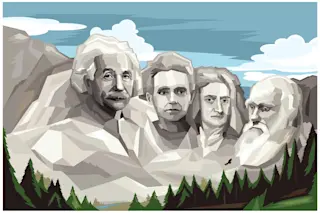Key Takeaways on the Top 10 Famous Scientists:
- Albert Einstein: Famous for the theory of relativity, and challenged conventional notions and reshaped our understanding of the universe.
- Marie Curie: Famous for pioneering work in radioactivity and the first woman to receive a Nobel Prize.
- Isaac Newton: Famous for Newton's laws of motion and gravitation, and is considered one of the key figures in the scientific revolution of the 17th century.
- Charles Darwin: Famous for his theory of evolution through natural selection.
- Nikola Tesla: Famous for electricity, magnetism, and wireless power transmission concepts.
- Galileo Galilei: Famous for his astronomical observations and our understanding of motion.
- Ada Lovelace: Famous for being the world’s first computer programmer. She defied the conventions of her era and transformed the world of computer science.
- Pythagoras: Famous for the Pythagorean theorem and transforming mathematics.
- Carl Linnaeus: Famous for naming living organisms. His innovative system of binomial nomenclature not only simplified the process of scientific communication but also laid the foundation for modern taxonomy.
- Rosalind Franklin: Famous for X-ray crystallography and groundbreaking research on the structure of DNA.
From unraveling the mysteries of the cosmos to unearthing the origins of humanity, these famous scientists have not only expanded the boundaries of human knowledge but have also profoundly altered the way we live, work, and perceive the world around us. The relentless pursuit of knowledge by these visionary thinkers has propelled humanity forward in ways that were once unimaginable.
These exceptional individuals have made an extraordinary impact on fields including physics, chemistry, biology, astronomy, and numerous others. Their contributions stand as a testament to the transformative power of human curiosity and the enduring impact of those who dared to ask questions, challenge the status quo, and change the world. Join us as we embark on a journey through the lives and legacies of the greatest scientists of all time.
1. Albert Einstein: Famous Scientist for the Theory of Relativity

Famous scientist: Albert Einstein (Credit: Mark Marturello)
Mark Marturello
Albert Einstein was not only a scientific genius but also a figure of enduring popularity and intrigue. His remarkable contributions to science, which include the famous equation E = mc2 and the theory of relativity, challenged conventional notions and reshaped our understanding of the universe.
Early Life
Born in Ulm, Germany, in 1879, Einstein was a precocious child. As a teenager, he wrote a paper on magnetic fields. (Einstein never actually failed math, contrary to popular lore.) His career trajectory began as a clerk in the Swiss Patent Office in 1905, where he published his four groundbreaking papers, including his famous equation, E = mc2, which described the relationship between matter and energy.
Contributions
Einstein's watershed year of 1905 marked the publication of his most important papers, addressing topics such as Brownian motion, the photoelectric effect and special relativity. His work in special relativity introduced the idea that space and time are interwoven, laying the foundation for modern astronomy. In 1916, he expanded on his theory of relativity with the development of general relativity, proposing that mass distorts the fabric of space and time.
Awards
Although Einstein received the Nobel Prize in Physics in 1921, it wasn't for his work on general relativity but rather for his discovery of the photoelectric effect. His contributions to science earned him a prestigious place in the scientific community.
Key Moment
A crowd barged past dioramas, glass displays, and wide-eyed security guards in the American Museum of Natural History. Screams rang out as some runners fell and were trampled. Upon arriving at a lecture hall, the mob broke down the door.
The date was Jan. 8, 1930, and the New York museum was showing a film about Albert Einstein and his general theory of relativity. Einstein was not present, but 4,500 mostly ticketless people still showed up for the viewing. Museum officials told them “no ticket, no show,” setting the stage for, in the words of the Chicago Tribune, “the first science riot in history.”
Such was Einstein’s popularity. As a publicist might say, he was the whole package: distinctive look (untamed hair, rumpled sweater), witty personality (his quips, such as God not playing dice, would live on) and major scientific cred (his papers upended physics).
Read More: 5 Interesting Things About Albert Einstein
Death
Einstein, who died of heart failure in 1955, left behind a profound legacy in the world of science. His life's work extended beyond scientific discoveries, encompassing his role as a public intellectual, civil rights advocate, and pacifist.
Legacy
Albert Einstein's theory of general relativity remains one of his most celebrated achievements. It predicted the existence of black holes and gravitational waves, with physicists recently measuring the waves from the collision of two black holes over a billion light-years away. General relativity also underpins the concept of gravitational lensing, enabling astronomers to study distant cosmic objects in unprecedented detail.
“Einstein remains the last, and perhaps only, physicist ever to become a household name,” says James Overduin, a theoretical physicist at Towson University in Maryland.
Einstein's legacy goes beyond his scientific contributions. He is remembered for his imaginative thinking, a quality that led to his greatest insights. His influence as a public figure and his advocacy for civil rights continue to inspire generations.
“I am enough of an artist to draw freely upon my imagination,” he said in a Saturday Evening Post interview. “Knowledge is limited. Imagination encircles the world.”
— Mark Barna
Read More: 20 Brilliant Albert Einstein Quotes
2. Marie Curie: Famous for Pioneering Work in Radioactivity
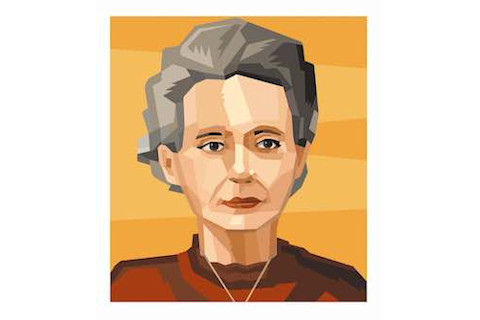
Famous scientist: Marie Curie (Credit: Mark Marturello)
Mark Marturello
Marie Curie's remarkable journey to scientific acclaim was characterized by determination and a thirst for knowledge. Living amidst poverty and political turmoil, her unwavering passion for learning and her contributions to the fields of physics and chemistry have made an everlasting impact on the world of science.
Early Life
Marie Curie, born as Maria Salomea Sklodowska in 1867 in Warsaw, Poland, faced immense challenges during her early life due to both her gender and her family's financial struggles. Her parents, fervent Polish patriots, sacrificed their wealth in support of their homeland's fight for independence from Russian, Austrian, and Prussian rule. Despite these hardships, Marie's parents, who were educators themselves, instilled a deep love for learning and Polish culture in her.
Marie and her sisters were initially denied higher education opportunities due to societal restrictions and lack of financial resources. In response, Marie and her sister Bronislawa joined a clandestine organization known as the Flying University, aimed at providing Polish education, forbidden under Russian rule.
Contributions
Marie Curie's path to scientific greatness began when she arrived in Paris in 1891 to pursue higher education. Inspired by the work of French physicist Henri Becquerel, who discovered the emissions of uranium, Marie chose to explore uranium's rays for her Ph.D. thesis. Her research led her to the groundbreaking discovery of radioactivity, revealing that matter could undergo atomic-level transformations.
Marie Curie collaborated with her husband, Pierre Curie, and together they examined uranium-rich minerals, ultimately discovering two new elements, polonium and radium. Their work was published in 1898, and within just five months, they announced the discovery of radium.
In 1903, Marie Curie, Pierre Curie, and Henri Becquerel were jointly awarded the Nobel Prize in Physics for their pioneering work in radioactivity. Marie became the first woman to receive a Nobel Prize, marking a historic achievement.
Read More: 5 Things You Didn't Know About Marie Curie
Awards
Tragedy struck in 1906 when Pierre Curie died suddenly in a carriage accident. Despite her grief, Marie Curie persevered and continued her research, taking over Pierre's position at the University of Paris. In 1911, she earned her second Nobel Prize, this time in Chemistry, for her remarkable contributions to the fields of polonium and radium.
Marie Curie's legacy extended beyond her Nobel Prizes. She made significant contributions to the fields of radiology and nuclear physics. She founded the Radium Institute in Paris, which produced its own Nobel laureates, and during World War I, she led France's first military radiology center, becoming the first female medical physicist.
Death
Marie Curie died in 1934 from a type of anemia that likely stemmed from her exposure to such extreme radiation during her career. In fact, her original notes and papers are still so radioactive that they’re kept in lead-lined boxes, and you need protective gear to view them
Legacy
Marie Curie's legacy endures as one of the greatest scientists of all time. She remains the only person to receive Nobel Prizes in two different scientific fields, a testament to her exceptional contributions to science. Her groundbreaking research in radioactivity revolutionized our understanding of matter and energy, leaving her mark on the fields of physics, chemistry, and medicine.
— Lacy Schley
Read More: Marie Curie: Iconic Scientist, Nobel Prize Winner … War Hero?
3. Isaac Newton: Famous for Newton's Laws of Motion and Gravitation
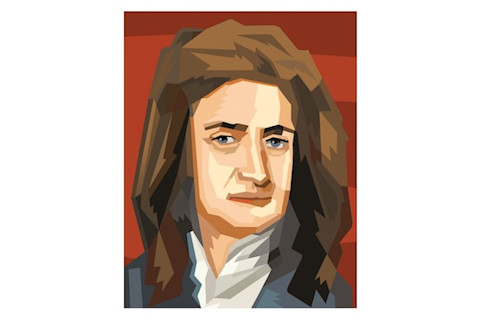
Famous scientist: Isaac Newton (Credit: Mark Marturello)
Mark Marturello
Isaac Newton was an English mathematician, physicist and astronomer who is widely recognized as one of the most influential scientists in history. He made groundbreaking contributions to various fields of science and mathematics and is considered one of the key figures in the scientific revolution of the 17th century.
Early Life
Isaac Newton was born on Christmas Day in 1642. Despite being a sickly infant, his survival was an achievement in itself. Just 23 years later, with Cambridge University closed due to the plague, Newton embarked on groundbreaking discoveries that would bear his name. He invented calculus, a new form of mathematics, as part of his scientific journey.
Contributions
Newton's introverted nature led him to withhold his findings for decades. It was only through the persistent efforts of his friend, Edmund Halley, who was famous for discovering comets, that Newton finally agreed to publish. Halley's interest was piqued due to a bet about planetary orbits, and Newton, having already solved the problem, astounded him with his answer.
Read More: 5 Eccentric Facts About Isaac Newton
The culmination of Newton's work was the "Philosophiæ Naturalis Principia Mathematica," commonly known as the Principia, published in 1687. This monumental work not only described the motion of planets and projectiles but also revealed the unifying force of gravity, demonstrating that it governed both heavenly and earthly bodies. Newton's laws became the key to unlocking the universe's mysteries.
Newton's dedication to academia was unwavering. He rarely left his room except to deliver lectures, even if it meant addressing empty rooms. His contributions extended beyond the laws of motion and gravitation to encompass groundbreaking work in optics, color theory, the development of reflecting telescopes bearing his name, and fundamental advancements in mathematics and heat.
Awards
In 1692, Newton faced a rare failure and experienced a prolonged nervous breakdown, possibly exacerbated by mercury poisoning from his alchemical experiments. Although he ceased producing scientific work, his influence in the field persisted.
Achievements
Newton spent his remaining three decades modernizing England's economy and pursuing criminals. In 1696, he received a royal appointment as the Warden of the Mint in London. Despite being viewed as a cushy job with a handsome salary, Newton immersed himself in the role. He oversaw the recoinage of English currency, provided economic advice, established the gold standard, and introduced ridged coins that prevented the tampering of precious metals. His dedication extended to pursuing counterfeiters vigorously, even infiltrating London's criminal networks, and witnessing their executions.
Newton's reputation among his peers was marred by his unpleasant demeanor. He had few close friends, never married, and was described as "insidious, ambitious, and excessively covetous of praise, and impatient of contradiction" by Astronomer Royal John Flamsteed. Newton held grudges for extended periods and engaged in famous feuds, notably with German scientist Gottfried Leibniz over the invention of calculus and English scientist Robert Hooke.
Legacy
Isaac Newton's legacy endures as one of the world's greatest scientists. His contributions to physics, mathematics, and various scientific disciplines shifted human understanding. Newton's laws of motion and gravitation revolutionized the field of physics and continue to be foundational principles.
His work in optics and mathematics laid the groundwork for future scientific advancements. Despite his complex personality, Newton's legacy as a scientific visionary remains unparalleled.
How fitting that the unit of force is named after stubborn, persistent, amazing Newton, himself a force of nature.
— Bill Andrews
Read More: Isaac Newton, World's Most Famous Alchemist
4. Charles Darwin: Famous for Theory of Evolution Through Natural Selection
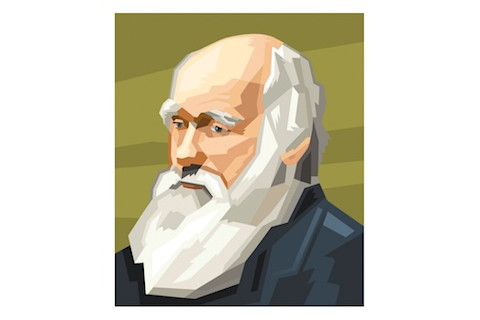
Famous scientist: Charles Darwin (Credit: Mark Marturello)
Mark Marturello
Charles Darwin has become one of the world's most renowned scientists. His inspiration came from a deep curiosity about beetles and geology, setting him on a transformative path. His theory of evolution through natural selection challenged prevailing beliefs and left an enduring legacy that continues to shape the field of biology and our understanding of life on Earth.
Early Life
Charles Darwin, an unlikely revolutionary scientist, began his journey with interests in collecting beetles and studying geology. As a young man, he occasionally skipped classes at the University of Edinburgh Medical School to explore the countryside. His path to becoming the father of evolutionary biology took an unexpected turn in 1831 when he received an invitation to join a world-spanning journey aboard the HMS Beagle.
Contributions
During his five-year voyage aboard the HMS Beagle, Darwin observed and documented geological formations, various habitats and the diverse flora and fauna across the Southern Hemisphere. His observations led to a paradigm-shifting realization that challenged the prevailing Victorian-era theories of animal origins rooted in creationism.
Darwin noticed subtle variations within the same species based on their environments, exemplified by the unique beak shapes of Galapagos finches adapted to their food sources. This observation gave rise to the concept of natural selection, suggesting that species could change over time due to environmental factors, rather than divine intervention.
Read More: 7 Things You May Not Know About Charles Darwin
Upon his return, Darwin was initially hesitant to publish his evolutionary ideas, instead focusing on studying his voyage samples and producing works on geology, coral reefs and barnacles. He married his first cousin, Emma Wedgwood, and they had ten children, with Darwin actively engaging as a loving and attentive father — an uncommon practice among eminent scientists of his era.
Darwin's unique interests in taxidermy, unusual food and his struggle with ill health did not deter him from his evolutionary pursuits. Over two decades, he meticulously gathered overwhelming evidence in support of evolution.
Publication
All of his observations and musings eventually coalesced into the tour de force that was On the Origin of Species, published in 1859 when Darwin was 50 years old. The 500-page book sold out immediately, and Darwin would go on to produce six editions, each time adding to and refining his arguments.
In non-technical language, the book laid out a simple argument for how the wide array of Earth’s species came to be. It was based on two ideas: that species can change gradually over time, and that all species face difficulties brought on by their surroundings. From these basic observations, it stands to reason that those species best adapted to their environments will survive and those that fall short will die out.
Legacy
Despite facing fierce criticism from proponents of creationism and the religious establishment, Darwin's theory of natural selection and evolution eventually gained acceptance in the 1930s. His work revolutionized scientific thought and remains largely intact to this day.
His theory, meticulously documented and logically sound, has withstood the test of time and scrutiny. Jerry Coyne, a professor emeritus at the University of Chicago, emphasizes the profound impact of Darwin's theory, stating that it "changed people’s views in so short a time" and that "there’s nothing you can really say to go after the important aspects of Darwin’s theory."
— Nathaniel Scharping
Read More: 8 Inspirational Sayings From Charles Darwin
5. Nikola Tesla: Famous for Electricity, Magnetism, and Wireless Power Transmission Concepts

Famous scientist: Nikola Tesla (Credit: Mark Marturello)
Mark Marturello
Nikola Tesla grips his hat in his hand. He points his cane toward Niagara Falls and beckons bystanders to turn their gaze to the future. This bronze Tesla — a statue on the Canadian side — stands atop an induction motor, the type of engine that drove the first hydroelectric power plant.
Nikola Tesla exhibited a remarkable aptitude for science and invention from an early age. His work in electricity, magnetism and wireless power transmission concepts, established him as an eccentric but brilliant pioneer in the field of electrical engineering.
Early Life
Nikola Tesla, a Serbian-American engineer, was born in 1856 in what is now Croatia. His pioneering work in the field of electrical engineering laid the foundation for our modern electrified world. Tesla's groundbreaking designs played a crucial role in advancing alternating current (AC) technology during the early days of the electric age, enabling the transmission of electric power over vast distances, ultimately lighting up American homes.
Contributions
One of Tesla's most significant contributions was the development of the Tesla coil, a high-voltage transformer that had a profound impact on electrical engineering. His innovative techniques allowed for wireless transmission of power, a concept that is still being explored today, particularly in the field of wireless charging, including applications in cell phones.
Tesla's visionary mind led him to propose audacious ideas, including a grand plan involving a system of towers that could harness energy from the environment and transmit both signals and electricity wirelessly around the world. While these ideas were intriguing, they were ultimately deemed impractical and remained unrealized. Tesla also claimed to have invented a "death ray," adding to his mystique.
Read More: What Did Nikola Tesla Do? The Truth Behind the Legend
Awards
Tesla's eccentric genius and prolific inventions earned him widespread recognition during his lifetime. He held numerous patents and made significant contributions to the field of electrical engineering. While he did not invent alternating current (AC), he played a pivotal role in its development and promotion. His ceaseless work and inventions made him a household name, a rare feat for scientists in his era.
Legacy
In recent years, Tesla's legacy has taken on a life of its own, often overshadowing his actual inventions. He has become a symbol of innovation and eccentricity, inspiring events like San Diego Comic-Con, where attendees dress as Tesla. Perhaps most notably, the world's most famous electric car company bears his name, reflecting his ongoing influence on the electrification of transportation.
While Tesla's mystique sometimes veered into the realm of self-promotion and fantastical claims, his genuine contributions to electrical engineering cannot be denied. He may not have caused earthquakes with his inventions or single handedly discovered AC, but his visionary work and impact on the electrification of the world continue to illuminate our lives.
— Eric Betz
Read More: These 7 Famous Physicists Are Still Alive Today
6. Galileo Galilei: Famous for his Astronomical Observations and Our Understanding of Motion

Famous scientist: Galileo Galilei (Credit: Mark Marturello)
Mark Marturello
Galileo Galilei, an Italian mathematician, made a pivotal contribution to modern astronomy around December 1609. At the age of 45, he turned a telescope towards the moon and ushered in a new era in the field.
His observations unveiled remarkable discoveries, such as the presence of four large moons orbiting Jupiter and the realization that the Milky Way's faint glow emanated from countless distant stars. Additionally, he identified sunspots on the surface of the sun and observed the phases of Venus, providing conclusive evidence that Venus orbited the sun within Earth's own orbit.
Contributions
While Galileo didn't invent the telescope and wasn't the first to use one for celestial observations, his work undeniably marked a turning point in the history of science. His groundbreaking findings supported the heliocentric model proposed by Polish astronomer Nicolaus Copernicus, who had revolutionized astronomy with his sun-centered solar system model.
Beyond his astronomical observations, Galileo made significant contributions to the understanding of motion. He demonstrated that objects dropped simultaneously would hit the ground at the same time, irrespective of their size, illustrating that gravity isn't dependent on an object's mass. His law of inertia also played a critical role in explaining the Earth's rotation.
Read More: 12 Fascinating Facts About Galileo Galilei You May Not Know
Awards
Galileo's discoveries, particularly his support for the Copernican model of the solar system, brought him into conflict with the Roman Catholic Church. In 1616, an inquisition ordered him to cease promoting heliocentrism, as it contradicted the church's geocentric doctrine based on Aristotle's outdated views of the cosmos.
The situation worsened in 1633 when Galileo published a work comparing the Copernican and Ptolemaic systems, further discrediting the latter. Consequently, the church placed him under house arrest, where he remained until his death in 1642.
Legacy
Galileo's legacy endured despite the challenges he faced from religious authorities. His observations and pioneering work on celestial bodies and motion laid the foundation for modern astronomy and physics.
His law of inertia, in particular, would influence future scientists, including Sir Isaac Newton, who built upon Galileo's work to formulate a comprehensive set of laws of motion that continue to guide spacecraft navigation across the solar system today. Notably, NASA's Galileo mission to Jupiter, launched centuries later, demonstrated the enduring relevance of Galileo's contributions to the field of space exploration.
— E.B.
Read More: Galileo Galilei's Legacy Went Beyond Science
7. Ada Lovelace: Famous For Being the World’s First Computer Programmer

Famous scientist: Ada Lovelace (Credit: Mark Marturello)
Mark Marturello
Ada Lovelace defied the conventions of her era and transformed the world of computer science. She is known as the world's first computer programmer. Her legacy endures, inspiring generations of computer scientists and earning her the title of the "Enchantress of Numbers.”
Early Life
Ada Lovelace, born Ada Byron, made history as the world's first computer programmer, a remarkable achievement considering she lived a century before the advent of modern computers. Her journey into the world of mathematics and computing began in the early 1830s when she was just 17 years old.
Ada, the only legitimate child of the poet Lord Byron, entered into a pivotal collaboration with British mathematician, inventor, and engineer Charles Babbage. Babbage had conceived plans for an intricate machine called the Difference Engine — essentially a massive mechanical calculator.
Read More: Meet Ada Lovelace, The First Computer Programmer
Contributions
At a gathering in the 1830s, Babbage exhibited an incomplete prototype of his Difference Engine. Among the attendees was the young Ada Lovelace, who, despite her age, grasped the workings of the machine. This encounter marked the beginning of a profound working relationship and close friendship between Lovelace and Babbage that endured until her untimely death in 1852 at the age of 36. Inspired by Babbage's innovations, Lovelace recognized the immense potential of his latest concept, the Analytical Engine.
The Analytical Engine was more than a mere calculator. Its intricate mechanisms, coupled with the ability for users to input commands through punch cards, endowed it with the capacity to perform a wide range of mathematical tasks. Lovelace, in fact, went a step further by crafting instructions for solving a complex mathematical problem, effectively creating what many historians later deemed the world's first computer program. In her groundbreaking work, Lovelace laid the foundation for computer programming, defining her legacy as one of the greatest scientists.
Legacy
Ada Lovelace's contributions to the realm of "poetical science," as she termed it, are celebrated as pioneering achievements in computer programming and mathematics. Despite her tumultuous personal life marked by gambling and scandal, her intellectual brilliance and foresight into the potential of computing machines set her apart. Charles Babbage himself described Lovelace as an "enchantress" who wielded a remarkable influence over the abstract realm of science, a force equivalent to the most brilliant male intellects of her time.
— L.S.
Read More: Meet 10 Women in Science Who Changed the World
8. Pythagoras: Famous for the Pythagorean Theorem
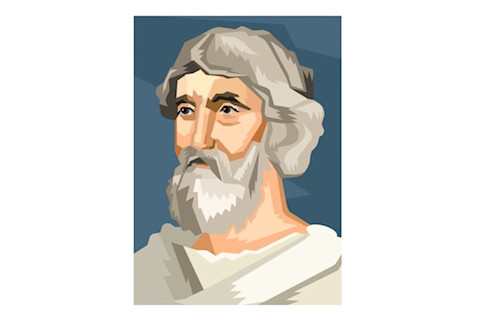
Famous scientist: Pythagoras (Credit: Mark Marturello)
Mark Marturello
Pythagoras left an enduring legacy in the world of mathematics that continues to influence the field to this day. While his famous Pythagorean theorem, which relates the sides of a right triangle, is well-known, his broader contributions to mathematics and his belief in the fundamental role of numbers in the universe shaped the foundations of geometry and mathematical thought for centuries to come.
Early Life
Pythagoras, a Greek philosopher and mathematician, lived in the sixth century B.C. He is credited with the Pythagorean theorem, although the origins of this mathematical concept are debated.
Contributions
Pythagoras is most famous for the Pythagorean theorem, which relates the lengths of the sides of a right triangle. While he may not have been the first to discover it, he played a significant role in its development. His emphasis on the importance of mathematical concepts laid the foundation for modern geometry.
Awards
Pythagoras did not receive formal awards, but his legacy in mathematics and geometry is considered one of the cornerstones of scientific knowledge.
Legacy
Pythagoras' contributions to mathematics, particularly the Pythagorean theorem, have had a lasting impact on science and education. His emphasis on the importance of mathematical relationships and the certainty of mathematical proofs continues to influence the way we understand the world.
— M.B.
Read More: The Origin Story of Pythagoras and His Cult Followers
9. Carl Linnaeus: Famous for His System of Naming Living Organisms
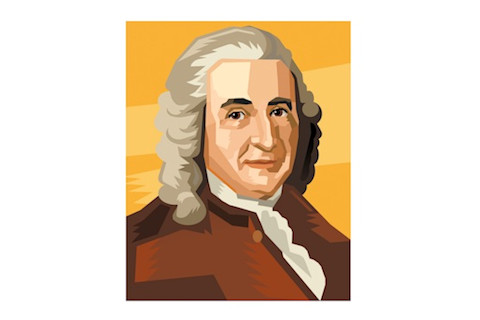
Famous scientist: Carl Linnaeus (Credit: Mark Marturello)
Mark Marturello
Carl Linnaeus embarked on a mission to improve the chaos of naming living organisms. His innovative system of binomial nomenclature not only simplified the process of scientific communication but also laid the foundation for modern taxonomy, leaving an enduring legacy in the field of biology.
Early Life
It started in Sweden: a functional, user-friendly innovation that took over the world, bringing order to chaos. No, not an Ikea closet organizer. We’re talking about the binomial nomenclature system, which has given us clarity and a common language, devised by Carl Linnaeus.
Linnaeus, born in southern Sweden in 1707, was an “intensely practical” man, according to Sandra Knapp, a botanist and taxonomist at the Natural History Museum in London. He lived at a time when formal scientific training was scant and there was no system for referring to living things. Plants and animals had common names, which varied from one location and language to the next, and scientific “phrase names,” cumbersome Latin descriptions that could run several paragraphs.
Contributions
While Linnaeus is often hailed as the father of taxonomy, his primary focus was on naming rather than organizing living organisms into evolutionary hierarchies. The task of ordering species would come later, notably with the work of Charles Darwin in the following century. Despite advancements in our understanding of evolution and the impact of genetic analysis on biological classification, Linnaeus' naming system endures as a simple and adaptable means of identification.
The 18th century was also a time when European explorers were fanning out across the globe, finding ever more plants and animals new to science.
“There got to be more and more things that needed to be described, and the names were becoming more and more complex,” says Knapp.
Linnaeus, a botanist with a talent for noticing details, first used what he called “trivial names” in the margins of his 1753 book Species Plantarum. He intended the simple Latin two-word construction for each plant as a kind of shorthand, an easy way to remember what it was.
“It reflected the adjective-noun structure in languages all over the world,” Knapp says of the trivial names, which today we know as genus and species. The names moved quickly from the margins of a single book to the center of botany, and then all of biology. Linnaeus started a revolution — positioning him as one of the greatest scientists — but it was an unintentional one.
Legacy
Today we regard Linnaeus as the father of taxonomy, which is used to sort the entire living world into evolutionary hierarchies, or family trees. But the systematic Swede was mostly interested in naming things rather than ordering them, an emphasis that arrived the next century with Charles Darwin.
As evolution became better understood and, more recently, genetic analysis changed how we classify and organize living things, many of Linnaeus’ other ideas have been supplanted. But his naming system, so simple and adaptable, remains.
“It doesn’t matter to the tree in the forest if it has a name,” Knapp says. “But by giving it a name, we can discuss it. Linnaeus gave us a system so we could talk about the natural world.”
— Gemma Tarlach
Read More: Is Plant Communication a Real Thing?
10. Rosalind Franklin: Famous for X-ray Crystallography and Groundbreaking Research on Structure of DNA
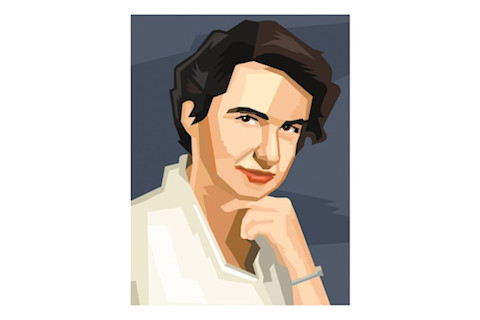
Famous scientist: Rosalind Franklin (Credit: Mark Marturello)
Mark Marturello
Rosalind Franklin, a brilliant and tenacious scientist, transformed the world of molecular biology. Her pioneering work in X-ray crystallography and groundbreaking research on the structure of DNA propelled her to the forefront of scientific discovery. Yet, her remarkable contributions were often overshadowed, and her legacy is not only one of scientific excellence but also a testament to the persistence and resilience of a scientist who deserved greater recognition in her time.
Early Life
Rosalind Franklin, one of the greatest scientists of her time, was a British-born firebrand and perfectionist. While she had a reputation for being somewhat reserved and difficult to connect with, those who knew her well found her to be outgoing and loyal. Franklin's brilliance shone through in her work, particularly in the field of X-ray crystallography, an imaging technique that revealed molecular structures based on scattered X-ray beams. Her early research on the microstructures of carbon and graphite remains influential in the scientific community.
Contributions
However, it was Rosalind Franklin's groundbreaking work with DNA that would become her most significant contribution. During her time at King's College London in the early 1950s, she came close to proving the double-helix theory of DNA. Her achievement was epitomized in "photograph #51," which was considered the finest image of a DNA molecule at that time. Unfortunately, her work was viewed by others, notably James Watson and Francis Crick.
Watson saw photograph #51 through her colleague Maurice Wilkins, and Crick received unpublished data from a report Franklin had submitted to the council. In 1953, Watson and Crick published their iconic paper in "Nature," loosely citing Franklin's work, which also appeared in the same issue.
Awards
Rosalind Franklin's pivotal role in elucidating the structure of DNA was overlooked when the Nobel Prize was awarded in 1962 to James Watson, Francis Crick, and Maurice Wilkins. This omission is widely regarded as one of the major snubs of the 20th century in the field of science.
Death
Despite her groundbreaking work and significant contributions to science, Franklin's life was tragically cut short. In 1956, at the height of her career, she was diagnosed with ovarian cancer, possibly linked to her extensive X-ray work. Remarkably, she continued to work in the lab until her passing in 1958 at the young age of 37.
Legacy
Rosalind Franklin's legacy endures not only for her achievements but also for the recognition she deserved but did not receive during her lifetime. She was known for her extreme clarity and perfectionism in all her scientific endeavors, changing the field of molecular biology. While many remember her for her contributions, she is also remembered for how her work was overshadowed and under appreciated, a testament to her enduring influence on the world of science.
“As a scientist, Miss Franklin was distinguished by extreme clarity and perfection in everything she undertook,” Bernal wrote in her obituary, published in Nature. Though it’s her achievements that close colleagues admired, most remember Franklin for how she was forgotten.
— Carl Engelking
Read More: The Unsung Heroes of Science
More Famous Scientists and Their Discoveries
11. Isaac Asimov (1920–1992)
Asimov was my gateway into science fiction, then science, then everything else. He penned some of the genre’s most iconic works — fleshing out the laws of robotics, the messiness of a galactic empire, the pitfalls of predicting the future — in simple, effortless prose. A trained biochemist, the Russian-born New Yorker wrote prolifically, producing over 400 books, not all science-related: Of the 10 Dewey Decimal categories, he has books in nine. — B.A.
12. Richard Feynman (1918–1988)
Feynman played a part in most of the highlights of 20th-century physics. In 1941, he joined the Manhattan Project. After the war, his Feynman diagrams — for which he shared the ’65 Nobel Prize in Physics — became the standard way to show how subatomic particles interact. As part of the 1986 space shuttle Challenger disaster investigation, he explained the problems to the public in easily understandable terms, his trademark. Feynman was also famously irreverent, and his books pack lessons I live by. — E.B.
13. Robert FitzRoy (1805–1865)
FitzRoy suffered for science, and for that I respect him. As captain of the HMS Beagle, he sailed Charles Darwin around the world, only to later oppose his shipmate’s theory of evolution while waving a Bible overhead. FitzRoy founded the U.K.’s Met Office in 1854, and he was a pioneer of prediction; he coined the term weather forecast. But after losing his fortunes, suffering from depression and poor health, and facing fierce criticism of his forecasting system, he slit his throat in 1865. — C.E.
14. Jean-Baptiste Lamarck (1744–1829)
Lamarck may be remembered as a failure today, but to me, he represents an important step forward for evolutionary thinking. Before he suggested that species could change over time in the early 19th century, no one took the concept of evolution seriously. Though eventually proven wrong, Lamarck’s work brought the concept of evolution into the light and would help shape the theories of a young Charles Darwin. Science isn’t all about dazzling successes; it’s also a story of failures surmounted and incremental advances. — N.S.
15. Lucretius (99 B.C.–55 B.C.)
My path to the first-century B.C. Roman thinker Titus Lucretius Carus started with Ralph Waldo Emerson and Michele de Montaigne, who cited him in their essays. Lucretius’ only known work, On the Nature of Things, is remarkable for its foreshadowing of Darwinism, humans as higher primates, the study of atoms and the scientific method — all contemplated in a geocentric world ruled by eccentric gods. — M.B.
16. Katharine McCormick (1875–1967)
McCormick planned to attend medical school after earning her biology degree from MIT in 1904. Instead, she married rich. After her husband’s death in 1947, she used her inheritance to provide crucial funding for research on the hormonal birth control pill. She also fought to make her alma mater more accessible to women, leading to an all-female dormitory, allowing more women to enroll. As a feminist interested in science, I’d love to be friends with this badass advocate for women’s rights. — L.S.
17. John Muir (1838–1914)
In 1863, Muir abandoned his eclectic combination of courses at the University of Wisconsin to wander instead the “University of the Wilderness” — a school he never stopped attending. A champion of the national parks (enough right there to make him a hero to me!), Muir fought vigorously for conservation and warned, “When we try to pick out anything by itself, we find it hitched to everything else in the Universe.” It’s a reminder we need today, more than ever. — Elisa Neckar
18. Rolf O. Peterson (1944–)
Peterson helms the world’s longest-running study of the predator-prey relationship in the wild, between wolves and moose on Isle Royale in the middle of Lake Superior. He’s devoted more than four decades to the 58-year wildlife ecology project, a dedication and passion indicative, to me, of what science is all about. As the wolf population has nearly disappeared and moose numbers have climbed, patience and emotional investment like his are crucial in the quest to learn how nature works. — Becky Lang
19. Marie Tharp (1920–2006)
I love maps. So did geologist and cartographer Tharp. In the mid-20th century, before women were permitted aboard research vessels, Tharp explored the oceans from her desk at Columbia University. With the seafloor — then thought to be nearly flat — her canvas, and raw data her inks, she revealed a landscape of mountain ranges and deep trenches. Her keen eye also spotted the first hints of plate tectonics at work beneath the waves. Initially dismissed, Tharp’s observations would become crucial to proving continental drift. — G.T.
20. George Washington Carver (1864-1943)
Born into slavery in 1864, George Washington Carver is best known for his innovations in farming, soil restoration and peanuts. After the Civil War ended, Carver and his older brother James learned to read and write. Though his brother soon turned to farming, Carver focused on his studies and interest in botany — even learning how to mix herbal remedies and nurse plants back to health, earning him the nickname “the plant doctor.” Carver’s research led to the idea of crop rotation, and is also credited for the idea of permaculture, in which carbon is pulled from the atmosphere to improve crop growth. This is a key factor in combating climate change and is used in some farms today. — M.C.
Read more: The Dynasties That Changed Science
Making Science Popular With Other Greatest Scientists
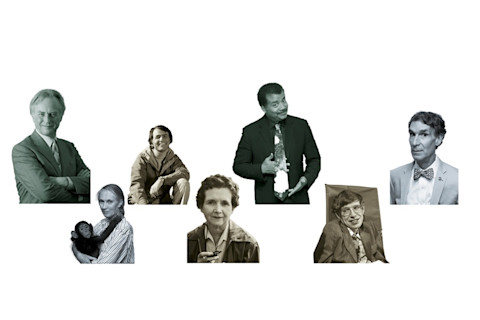
(Credits: Alfred Eisenstaedt/The LIFE Picture Collection/Getty Images; Astrid Stawiarz/Getty Images; Colin McPherson/Corbis via Getty Images; Everett Collection; Michel Gunther/Science Source; Robin Marchant/Getty Images; David Montgomery/Getty Images)
Science needs to get out of the lab and into the public eye. Over the past hundred years or so, these other greatest scientists have made it their mission. They left their contributions in multiple sciences while making them broadly available to the general public.
21. Sean M. Carroll (1966– )
The physicist (and one-time Discover blogger) has developed a following among space enthusiasts through his lectures, television appearances and books, including The Particle at the End of the Universe, on the Higgs boson.
22. Rachel Carson (1907–1964)
With her 1962 book Silent Spring, the biologist energized a nascent environmental movement. In 2006, Discover named Silent Spring among the top 25 science books of all time.
23. Richard Dawkins (1941– )
The biologist, a charismatic speaker, first gained public notoriety in 1976 with his book The Selfish Gene, one of his many works on evolution.
24. Jane Goodall (1934– )
Studying chimpanzees in Tanzania, Goodall’s patience and observational skills led to fresh insights into their behavior — and led her to star in a number of television documentaries.
25. Stephen Jay Gould (1941–2002)
In 1997, the paleontologist Gould was a guest on The Simpsons, a testament to his broad appeal. Among scientists, Gould was controversial for his idea of evolution unfolding in fits and starts rather than in a continuum.
26. Stephen Hawking (1942–2018)
His books’ titles suggest the breadth and boldness of his ideas: The Universe in a Nutshell, The Theory of Everything. “My goal is simple,” he has said. “It is a complete understanding of the universe, why it is as it is and why it exists at all.”
27. Aldo Leopold (1887–1948)
If Henry Thoreau and John Muir primed the pump for American environmentalism, Leopold filled the first buckets. His posthumously published A Sand County Almanac is a cornerstone of modern environmentalism.
28. Bill Nye (1955– )
What should an engineer and part-time stand-up comedian do with his life? For Nye, the answer was to become a science communicator. In the ’90s, he hosted a popular children’s science show and more recently has been an eloquent defender of evolution in public debates with creationists.
29. Oliver Sacks (1933–2015)
The neurologist began as a medical researcher, but found his calling in clinical practice and as a chronicler of strange medical maladies, most famously in his book The Man Who Mistook His Wife for a Hat.
30. Carl Sagan (1934–1996)
It’s hard to hear someone say “billions and billions” and not hear Sagan’s distinctive voice, and remember his 1980 Cosmos: A Personal Voyage miniseries. Sagan brought the wonder of the universe to the public in a way that had never happened before.
31. Neil deGrasse Tyson (1958– )
The astrophysicist and gifted communicator is Carl Sagan’s successor as champion of the universe. In a nod to Sagan’s Cosmos, Tyson hosted the miniseries Cosmos: A Spacetime Odyssey in 2014.
32. E.O. Wilson (1929–2021)
The prolific, Pulitzer Prize-winning biologist first attracted broad public attention with 1975’s Sociobiology: The New Synthesis. His subsequent works have filled many a bookshelf with provocative discussions of biodiversity, philosophy and the animals he has studied most closely: ants. — M.B.
Read More: Who Was Anna Mani, and How Was She a Pioneer for Women in STEM?
The Next Generation of Famous Scientists
As science progresses, so does the roll call of new voices and greatest scientists serving as bridges between lab and layman. Here are some of our favorite emerging science stars:
33. British physicist Brian Cox
He became a household name in the U.K. in less than a decade, thanks to his accessible explanations of the universe in TV and radio shows, books and public appearances.
34. Neuroscientist Carl Hart
He debunks anti-science myths supporting misguided drug policies via various media, including his memoir High Price.
35. Emily Graslie
From the Amazon forest to the dissecting table, YouTube star and naturalist Emily brings viewers into the guts of the natural world, often literally.
36. Upulie Divisekera
When not talking dinosaurs or head transplants on Australian radio, molecular biologist Upulie coordinates @RealScientists, a rotating Twitter account for science outreach.
37. Raychelle Burks
Mixing pop culture and chemistry, analytical chemist Raychelle demystifies the molecules behind poisons, dyes and even Game of Thrones via video, podcast and blog.
38. Katharine Hayhoe
Climate scientist and evangelical Christian Katharine preaches beyond the choir about the planetary changes humans are causing in PBS’ Global Weirding video series.
— Ashley Braun
Read More: 6 Famous Archaeologists You Need to Know About
This article was originally published on April 11, 2017 and has since been updated with new information by the Discover staff.
Article Sources
Our writers at Discovermagazine.com use peer-reviewed studies and high-quality sources for our articles, and our editors review for scientific accuracy and editorial standards. Review the sources used below for this article:
- Advancing Physics. Einstein and Brownian Motion
- The Nobel Prize. Marie Curie
- Stanford Encyclopedia of Philosophy. Isaac Newton
- Britannica. The Principia of Isaac Newton
- Britannica. Charles Darwin
- Britannica. Beagle
- Britannica. Nikola Tesla
- Britannica. Telescopic discoveries of Galileo
- Computer History Museum. Ada Lovelace
- BBC Science Focus. How Ada Lovelace's notes on the Analytical Engine created the first computer program
- Britannica. Pythagoras
- New World Encyclopedia. Binomial nomenclature
- National Library of Medicine. Linnaean sources and concepts of orchids
- The Nobel Prize. Speed read: Deciphering life’s enigma code
- United States Environmental Protection Agency. Women in Radiation History: Rosalind Franklin
- Nature. Isaac Asimov: centenary of the great explainer
- National Park Service. John Muir
- National Women's History Museum. Rachel Carson
- Jane Goodall Institute. She blazed the trail. The next steps are up to us
- The New York Times. Stephen Hawking
- Wisconsin Historical Society. Leopold, Aldo, 1887-1948
- The New York Times. Oliver Sacks, Neurologist Who Wrote About the Brain’s Quirks, Dies at 82
- The New York Times. E.O. Wilson, a Pioneer of Evolutionary Biology, Dies at 92
- Advancing Physics. Brian Cox
- The New York Times. This Heroin-Using Professor Wants to Change How We Think About Drugs
- Forbes. Emily Graslie
- The Guardian. Upulie Divisekera
- American University. Raychelle Burks
- The New York Times. Katharine Hayhoe, a Climate Explainer Who Stays Above the Storm


